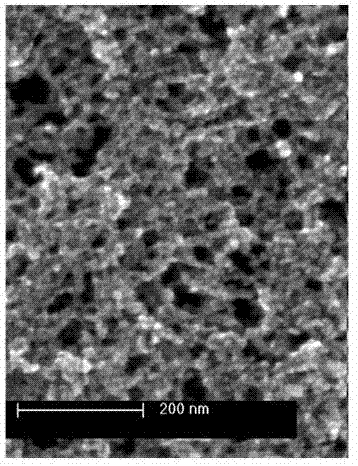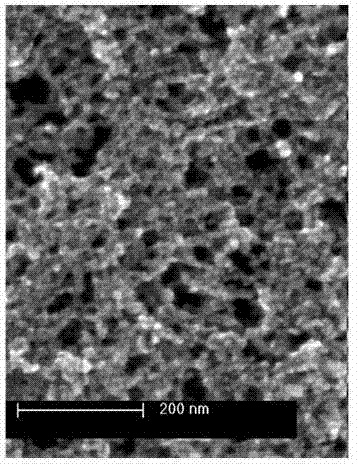Pd-based transition-metal-doped binary nano-porous material and preparation method thereof
A nanoporous, transition element technology, applied in the fields of nanoscience and nanoporous material preparation, to achieve the effect of strong element holding capacity and many systems
- Summary
- Abstract
- Description
- Claims
- Application Information
AI Technical Summary
Problems solved by technology
Method used
Image
Examples
Embodiment 1
[0032] A metallic glass prealloy for Ni doping (PdNi) 80 P 20 . The Ni content is 40 at%, the Pd content is 40 at%, and the P content is controlled around 20 at%. After washing and drying (NiPd) 80 P 20 As the working electrode, Pt is used as the counter electrode, and a saturated calomel electrode is used as the reference electrode. 2 SO 4 +0.1mol / L Ni 2+ + 0.2mol / L PO 4 -3 In a mixed corrosion solution, in 0.85-0.95V Dealloyed under conditions, when the current approached to zero, the dealloyed sample was taken out, and after cleaning, a PdNi binary nanoporous material was obtained, which had an internally connected bimodal pore structure. The size of the macropore in the nanopore is about 70-80nm, the size of the small hole is about 3-5nm, and the width of the connected metal ligament tissue is about 15-20nm. The Ni content is 1-3.5 at%.
[0033]
Embodiment 2
[0035] A metallic glass prealloy for Ni doping (PdNi) 80 P 20 . The Ni content can be 70 at%, the Pd content can be 10 at%, and the P content can be controlled around 20 at%. After washing and drying (NiPd) 80 P 20 As the working electrode, Pt was used as the counter electrode, and a saturated calomel electrode was used as the reference electrode, and it was placed in NaCl corrosion solution. 0.46-0.60V dealloyed under conditions, and when the current approaches zero, the dealloyed sample is taken out, and after cleaning, a PdNi binary nanoporous material is obtained, which has an internally connected bimodal pore structure. The size of the macropore in the nanopore is about 70-100nm, the size of the small hole is about 3-5nm, and the width of the connected metal ligament tissue is about 15-20nm. The Ni content is 1-4 at%.
[0036]
Embodiment 3
[0038] A Metallic Glass Prealloy for Cu Doping (PdCu) 80 P 20 . The Ni content can be 50 at%, the Pd content can be 30 at%, and the P content can be controlled around 20 at%. After washing and drying (PdCu) 80 P 20 As the working electrode, Pt was used as the counter electrode, and a saturated calomel electrode was used as the reference electrode. 2 SO 4 +0.1mol / L Cu 2+ In a mixed corrosion solution, in 0.80-0.85V dealloyed under the same conditions, and when the current approaches zero, the dealloyed sample is taken out, and after cleaning, a PdCu binary nanoporous material is obtained, which has an internally connected bimodal pore structure. The size of the macropore in the nanopore is about 70-100nm, the size of the small hole is about 3-5nm, and the width of the connected metal ligament tissue is about 15-20nm. The Cu content is 1-4 at%.
[0039]
PUM
| Property | Measurement | Unit |
|---|---|---|
| size | aaaaa | aaaaa |
Abstract
Description
Claims
Application Information
 Login to View More
Login to View More - R&D
- Intellectual Property
- Life Sciences
- Materials
- Tech Scout
- Unparalleled Data Quality
- Higher Quality Content
- 60% Fewer Hallucinations
Browse by: Latest US Patents, China's latest patents, Technical Efficacy Thesaurus, Application Domain, Technology Topic, Popular Technical Reports.
© 2025 PatSnap. All rights reserved.Legal|Privacy policy|Modern Slavery Act Transparency Statement|Sitemap|About US| Contact US: help@patsnap.com


